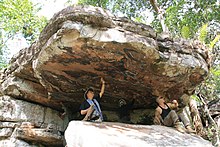
Back تاريخ كمبوديا المبكر Arabic Древна история на Камбоджа Bulgarian ប្រវត្តិសាស្ត្រខ្មែរដំបូង Cambodian Древняя история Камбоджи Russian கம்போடியாவின் தொடக்ககால வரலாறு Tamil ประวัติศาสตร์ยุคแรกของกัมพูชา Thai Buổi đầu lịch sử Campuchia Vietnamese

| History of Cambodia |
|---|
| Early history |
| Post-Angkor Period |
| Colonial period |
| Independence and conflict |
| Peace process |
| Modern Cambodia |
| By topic |
|
|
The early history of Cambodia follows the prehistoric and protohistoric development of Cambodia as a country in mainland Southeast Asia. Thanks to archaeological work carried out since 2009 this can now be traced back to the Neolithic period. As excavation sites have become more numerous and modern dating methods are applied, settlement traces of all stages of human civil development from neolithic hunter-gatherer groups to organized preliterate societies are documented in the region.[1][2][3][4]
Historical records of a political structure on territory that is now modern-day Cambodia first appear in Chinese annals in reference to Funan, a polity that encompassed the southernmost part of the Indochinese peninsula during the 1st to 6th centuries. Centered at the lower Mekong,[5] Funan is noted as the oldest regional Hindu culture, which suggests prolonged socio-economic interaction with maritime trading partners of the Indosphere in the west.[6] By the 6th century a civilization, titled Chenla or Zhenla in Chinese annals, had firmly replaced Funan, as it controlled larger, more undulating areas of Indochina and maintained more than a singular center of power.[7][8]
The Khmer Empire was established by the early 9th century in a mythical initiation and consecration ceremony to claim political legitimacy by founder Jayavarman II at Mount Kulen (Mount Mahendra) in 802 C.E.[9] A succession of powerful sovereigns, continuing the Hindu devaraja cult tradition, reigned over the classical era of Khmer civilization until the 11th century. A new dynasty of provincial origin introduced Buddhism as changes of religious, dynastic, administrative and military nature, environmental problems and ecological imbalance[10] coincide with shifts of power in Indochina.[11][12][13][14]
The royal chronology ends in the 14th century. Great achievements in administration, and accomplishments in agriculture, architecture, hydrology, logistics, urban planning and the arts are testimony to a creative and progressive civilization - in its complexity a cornerstone of Southeast Asian cultural legacy.[15]
- ^ Chandler, David (July 2009). "Cambodian History: Searching for the Truth". Cambodia Tribunal Monitor. Northwestern University School of Law Center for International Human Rights and Documentation Center of Cambodia. Retrieved 25 November 2015.
We have evidence of cave dwellers in northwestern Cambodia living as long ago as 5000 BCE.
- ^ Mourer, Cécile; Mourer, Roland (July 1970). "The Prehistoric Industry of Laang Spean, Province of Battambang, Cambodia". Archaeology & Physical Anthropology in Oceania. 5 (2): 128–146. JSTOR 40386114.
- ^ Schliesinger, Joachim (11 January 2015). Ethnic Groups of Cambodia Vol 1: Introduction and Overview By Joachim Schliesinger. BooksMango. ISBN 9781633232327. Retrieved 7 July 2015.
- ^ David Chandler, A History of Cambodia (Westview Publishers: Boulder Colorado, 2008) p. 13.
- ^ Stark, Miriam T. (2006). "Pre-Angkorian Settlement Trends in Cambodia's Mekong Delta and the Lower Mekong Archaeological Project" (PDF). Bulletin of the Indo-Pacific Prehistory Association. 26: 98–109. doi:10.7152/bippa.v26i0.11998 (inactive 20 February 2024). hdl:10524/1535. Archived from the original (PDF) on 23 September 2015. Retrieved 5 July 2015.
The Mekong delta played a central role in the development of Cambodia's earliest complex polities from approximately 500 BC to AD 600...
{{cite journal}}: CS1 maint: DOI inactive as of February 2024 (link) - ^ Stark, Miriam T.; Griffin, P. Bion; Phoeurn, Chuch; Ledgerwood, Judy; et al. (1999). "Results of the 1995–1996 Archaeological Field Investigations at Angkor Borei, Cambodia" (PDF). Asian Perspectives. 38 (1): 7–36. Archived from the original (PDF) on 23 September 2015. Retrieved 5 July 2015.
the development of maritime commerce and Hindu influence stimulated early state formation in polities along the coasts of mainland Southeast Asia, where passive indigenous populations embraced notions of statecraft and ideology introduced by outsiders...
- ^ ""What and Where was Chenla?", Recherches nouvelles sur le Cambodge" (PDF). Michael Vickery’s Publications. Retrieved 5 July 2015.
- ^ "Considerations on the Chronology and History of 9th Century Cambodia by Dr. Karl-Heinz Golzio, Epigraphist - ...the realm called Zhenla by the Chinese. Their contents are not uniform but they do not contradict each other" (PDF). Khmer Studies. Archived from the original (PDF) on 24 May 2015. Retrieved 5 July 2015.
- ^ Wolters, O. W. (1973). "Jayavarman II's Military Power: The Territorial Foundation of the Angkor Empire". The Journal of the Royal Asiatic Society of Great Britain and Ireland. 105 (1): 21–30. doi:10.1017/S0035869X00130400. JSTOR 25203407. S2CID 161969465.
- ^ "Scientists dig and fly over Angkor in search of answers to golden city's fall by Miranda Leitsinger". The San Diego Union-Tribune. 13 June 2004. Archived from the original on 24 December 2013. Retrieved 19 June 2015.
- ^ "The emergence and ultimate decline of the Khmer Empire - Many scholars attribute the halt of the development of Angkor to the rise of Theravada..." (PDF). Studies Of Asia. Retrieved 11 June 2015.
- ^ "What Caused the End of the Khmer Empire By K. Kris Hirst". About com. Archived from the original on 1 January 2017. Retrieved 11 June 2015.
- ^ "THE DECLINE OF ANGKOR". Encyclopædia Britannica, Inc. Retrieved 11 June 2015.
- ^ "The emergence and ultimate decline of the Khmer Empire was paralleled with development and subsequent change in religious ideology, together with infrastructure that supported agriculture" (PDF). Studies Of Asia. Retrieved 11 June 2015.
- ^ "Khmer Empire". World History Encyclopedia. Retrieved 7 July 2015.
© MMXXIII Rich X Search. We shall prevail. All rights reserved. Rich X Search